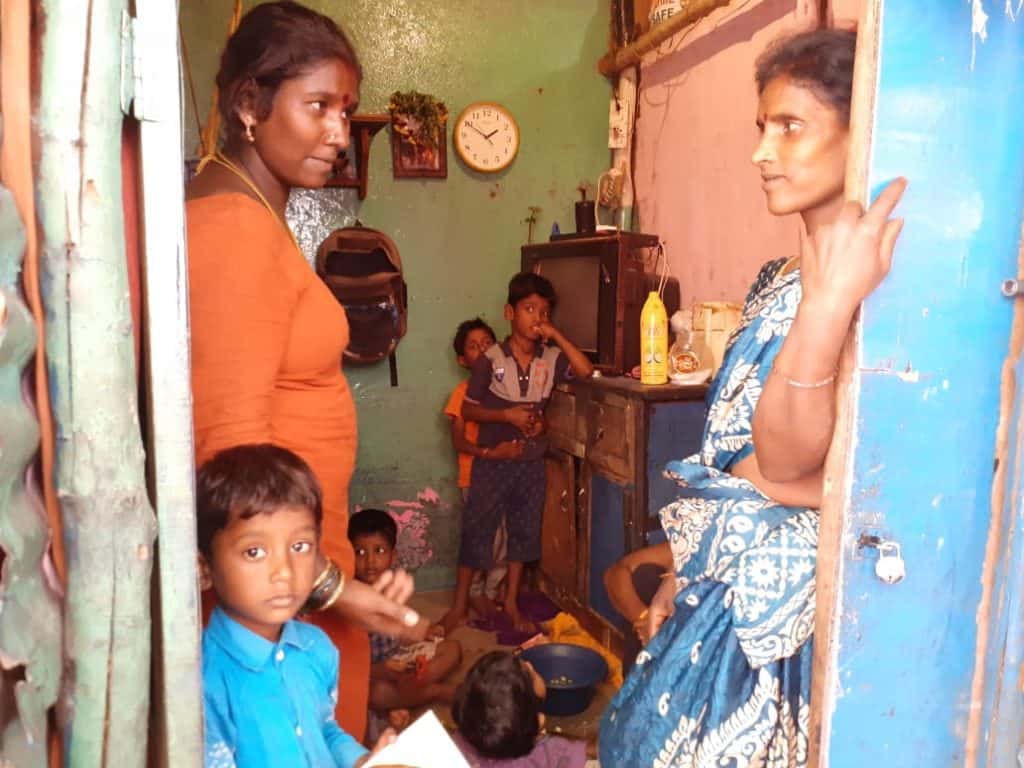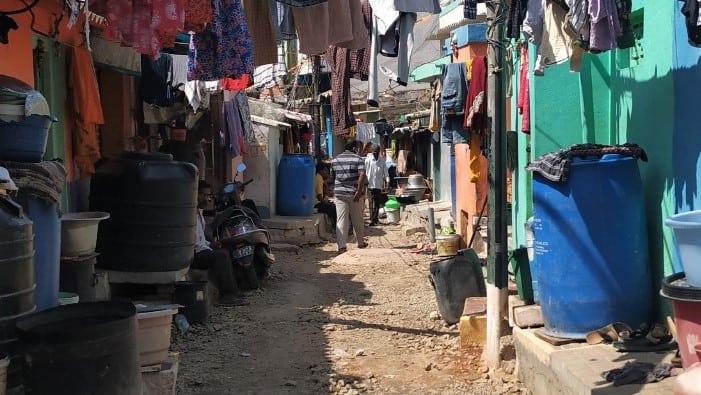
The state government and BBMP have been prescribing preventive measures ever since COVID-19 cases started to be reported in Bengaluru. But for the city’s low-income communities, these are nearly impossible to follow. For example, you can’t wash your hands regularly if you don’t have regular piped water supply, or practise social distancing in a densely-populated slum. As the city’s health system is overwhelmed, those living in slums are left without basic support. Residents who had come in contact with COVID-positive persons are unable to even self-quarantine due to space constraints at home.
Malarvizhi, Programme Officer at the NGO ActionAid Association, says the government’s COVID interventions have reduced in slums over time. “Earlier, healthcare workers [ASHA, ANM and Anganwadi] used to visit slums regularly, but that has also stopped in some settlements.”
Since the pandemic, ActionAid, along with the women’s rights group Mahila Slum Sangatane, has been working with over 50 slums around KR Market including Vinoba Nagar, Anjanappa Garden, Bhangi Colony and MCT Slum Quarters. “No one knows how to protect themselves or what to do if they test positive. The information flow to slums is very bad,” says Malarvizhi.
This is particularly worrying given that 25-35% of Bengaluru’s population is estimated to be living in slums. Malarvizhi says, “Some of these slums are over a hundred years old, and others decades old. During COVID, the problems they face are not the same as that of more affluent neighbourhoods.”
| No income, infrastructure or health facilities |
|---|
| Activists say that the first challenge in slums now is access to basic essentials and livelihood, since a large number of residents no longer have work. Dr Syvia Karpagam, a public health doctor and researcher, says, “Without access to food security and essentials, talking about healthcare during COVID is pointless.” Besides, a majority of the urban deprived are dependent on local government healthcare and small neighbourhood clinics, which aren’t functioning as usual. Malarvizhi says, “Till June, PHCs (Primary Health Centres) around KR Market were working, and clinics were seeing patients. But the last few weeks, all the small clinics have shut down, and some PHCs ask for a COVID-negative certificate to allow consultation for non-COVID medical issues.” The problems with infrastructure services – access to clear water, for example – are also cause for worry. Bhargavi Rao, independent consultant and researcher, asks, “There is no running water in so many slums in the city. Many of them were dependent on collecting water from nearby sources, which are off-limits now. How is anyone supposed to deal with COVID without clean water?” |
Slum communities can create their own quarantine centres
ActionAid and Slum Mahila Sangatane are now working on setting up community quarantine facilities in slums, for residents who have come in contact with COVID patients. Anveshi Research Centre for Women’s Studies, Hyderabad, has proposed similar solutions. They have created detailed advisories on how low-income communities can set up quarantine as well as reverse quarantine centres. Lakshmikutty, a PhD scholar and researcher at Anveshi, says, “We created these so that communities don’t have to depend on government announcements, and can protect themselves.”
How to set up a community quarantine centre in a slum
These centres are intended for those who are contacts of COVID patients or have just arrived in the city from elsewhere.
Where to set up the facility: Open, well-ventilated spaces in the community like schools, religious spaces, community halls, etc.
Essentials: Mattresses need to be placed six feet apart from each other. A healthy diet, drinking water, utensils, basic medical equipment and personal protective equipment like masks, need to be provided. NGOs like Action Aid and Slum Mahila Sangatane have been trying to raise funds for essentials like PPEs for the communities they are working with.
Organisation: Appoint a community supervisor from within the community, who can monitor residents daily. They can check temperature and oxygen saturation (SpO2 levels) if a pulse oximeter is available. Malarvizhi says, “We recently started video sessions with doctors to train volunteers from within the community. We are trying to find one volunteer for 50 houses each.”
Sanitation and sanitisation: The facility, especially commonly-used surfaces there, should be cleaned with disinfectants (phenyl/bleach) regularly. The bathroom must be cleaned with phenyl after each use, and a bucket of soap solution should be kept handy to clean touched surfaces. Use gloves while removing waste. All waste from the facility is to be treated as medical waste, and BBMP is to dispose of it.
Network: A lot of these requirements are hard to meet without support. Reach out to the government and demand help. The government should ideally provide advice, medical care, ambulance and essentials. Also reach out to NGOs, who can help provide essentials like mattresses and medicines for the facility. “It is actually the duty of ward committees to ensure water supply, electricity, waste management, etc. Communities should pressure their corporators to provide essentials,” says Bhargavi.
Coordination and communication: Communicate with local authorities about the facility in advance, and inform them immediately if someone tests positive. If possible, also reach out to healthcare providers nearby.
Read the complete advisory on community quarantine facilities here.

Reverse quarantine
Reverse quarantine is the practice of segregating healthy but vulnerable sections of the community, mainly the elderly (those aged above 65 years) and persons with co-morbid conditions like diabetes, heart disease, cancer, TB, HIV, those who’ve had organ transplant, etc. Such a facility was recently set up in a critical containment zone in Thiruvananthapuram, for example.
However, finding space for a reverse quarantine facility may not always be possible in low-income neighbourhoods. In such cases, Anveshi suggests segregation of the vulnerable person within the home itself, through these measures:
- Use a visible signal for segregation like a sari, chalk line, rope, etc.
- Don’t cross the line
- Don’t touch people across the line
- Talk from a distance of over 3 feet
Read the complete advisory on reverse quarantine here.
Government support is critical
While NGOs like Action Aid and Slum Mahila Sangtane are focusing on training community volunteers, facilitating slum residents’ access to the healthcare system and creating quarantine facilities, they acknowledge none of this is possible without government support.
“No NGO can do all this alone. Only governments have that kind of capacity. So we recently wrote a letter to the Health Department asking them to meet certain needs of slums which had been unacknowledged,” says Malarvizhi.
Some key demands in the letter are:
- Assistance with COVID facilities: Government should establish schools, private hospitals and grounds with temporary sheds with all facilities within the respective wards, to quarantine high-risk population with co-morbidities and to also isolate COVID-positive persons with mild/no symptoms.
- Medicines: Make generic medicine available, and make sure all government hospitals and PHCs service urban deprived communities.
- Pregnant Women: Take care of the needs of pregnant women as well as immunisation of children.
- Food Security: Nutritious diet should be provided to the families through PDS (Public Distribution System).
- Testing: Ensure COVID testing as was done in Dharavi, which was instrumental in containing the spread there.